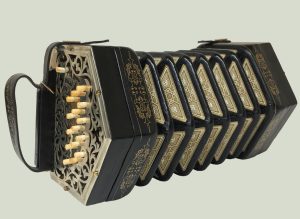
When it comes to traditional Irish instruments, few are as beloved or iconic as the accordion vs concertina. At a glance, these free-reed instruments may appear similar—they’re both played by expanding and compressing bellows—but their construction, sound, and playing techniques differ considerably.
Concertina vs Accordion: Key Differences
The concertina and accordion share historical roots, but they have evolved into distinct instruments with their own musical roles. The concertina is often favoured in Irish traditional music sessions for its portability and sharp, expressive tone. The accordion, meanwhile, offers a broader dynamic range and is well-suited to larger ensembles or stage performances.
The following table highlights the key differences between these instruments.
| Feature | Concertina | Accordion |
|---|---|---|
| Size and Portability | Smaller, compact, lightweight; ideal for travel and sessions | Heavier and bulkier; often requires shoulder straps for support |
| Sound and Volume | Delicate, focused, expressive sound; great for folk and acoustic settings | Rich, loud, and dynamic sound; suits ensembles and stage performances |
| Button Layout and Playing Style | Symmetrical button layout on both ends; Anglo, English, or Duet systems | Keyboard (piano/button) on right, bass/chords on left; wider harmonic use |
| Learning Curve and Accessibility | Steeper learning curve; fewer resources and non-standard layouts | Easier for beginners; standardized fingering and more learning materials |
Below, we examine the most important differences between the accordion and the concertina, analyzing size, tone, playability, and learning accessibility.
Size and Portability of a Concertina and an Accordion
One of the most obvious distinctions between concertinas and accordions is their size. Concertinas are generally smaller, more compact, and lighter, making them ideal for musicians on the move. In contrast, accordions—especially piano or chromatic models—can be heavier and bulkier, often requiring shoulder straps for support during performance. A good example is the mechanics of an Irish button accordion, which still features a more robust build and a bass system that adds to its weight and complexity compared to the concertina
Sound and Volume
Accordions tend to produce a richer and louder sound, suitable for orchestras, ensembles, or solo performances on stage. They have multiple reeds and registers, allowing for dynamic variation in tone. Concertinas, while expressive, deliver a more focused, delicate sound. This makes them ideal for traditional folk music and intimate acoustic settings, especially the anglo concertina.
Button Layout and Playing Style
The concertina vs accordion comparison also highlights contrasting keyboard layouts. Concertinas typically have a symmetrical button layout on both ends and come in English Concertina, Concertina, or Duet systems. Each type has its own logic for note placement. Accordions feature a keyboard (piano or button accordion) on the right and a bass/chord system on the left, offering a broader harmonic range but requiring more hand independence.
Learning Curve and Accessibility
Concertinas offer a steeper learning curve due to their non-standardized layouts and limited instructional materials. However, once mastered, they can be incredibly expressive. Accordions, particularly piano models, benefit from more learning resources, standardized fingering, and familiarity among musicians—making them more accessible for beginners accordions players.
Choosing Between the Accordion and the Concertina
If you’re debating between the accordion and the concertina, it’s not just about technical specs. Personal preferences, performance contexts, and even physical comfort can be decisive factors. It’s worth reflecting on how the instrument will fit into your musical lifestyle.
In this section, we’ll explore practical considerations that can help guide your choice—whether you’re buying your first instrument or looking to expand your collection with something new and expressive.
Your Musical Style and Performance Setting
If you’re into folk, sea shanties, or traditional dance tunes, the concertina is a natural fit. Its sharp attack and portability suit acoustic jams and pub sessions. For genres like tango, jazz, classical, or French musette, the accordion’s versatility and dynamic range shine—especially in amplified or ensemble settings.
Physical Comfort and Age Suitability
The lighter weight of a concertina makes it an excellent option for children, older adults, or anyone with mobility concerns. Meanwhile, the accordion may demand more upper body strength and endurance, which could be a factor during long rehearsals or live gigs.
Budget and Instrument Availability
Concertinas, particularly handmade models, can be expensive and less readily available than accordions. Entry-level accordions are often easier to find and may offer more features for the price. However, rare vintage concertinas are highly valued and can be worth the investment for serious folk musicians.
Frequently Asked Questions about Concertina vs Accordion
What is the main difference between a concertina and an accordion?
One of the most frequently asked questions about the concertina is how it differs from the accordion. While both are free-reed instruments, the concertina is more compact and features a symmetrical button layout, whereas the accordion is larger and includes either a piano or button keyboard along with a bass system. Their sound and playability also differ significantly
Is it easier to learn the accordion or the concertina?
The accordion—especially piano accordion—is generally easier to learn due to standardized fingering and more available tutorials. Concertinas, with their varied layouts (Anglo, English, Duet), have a steeper learning curve but offer great expressiveness once mastered.
Which is better for Irish music: concertina or accordion?
The concertina is often preferred in Irish traditional music thanks to its bright, agile tone and portability (Top 5 Best Concertina Albums) . However, accordions—especially the button type—are also used and valued for their rich harmonics in session or ensemble contexts.
Should I choose a concertina or an accordion as a beginner?
If you value portability and play mostly folk or acoustic music, start with a concertina. If you prefer versatility, wider genre use, and easier learning resources, the accordion might be the better beginner choice.





Share your thoughts